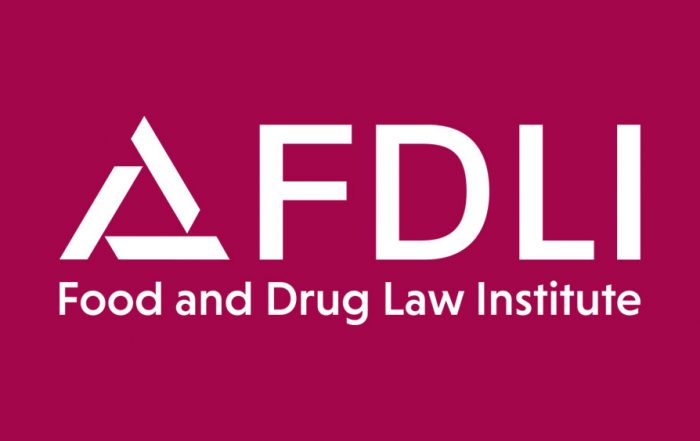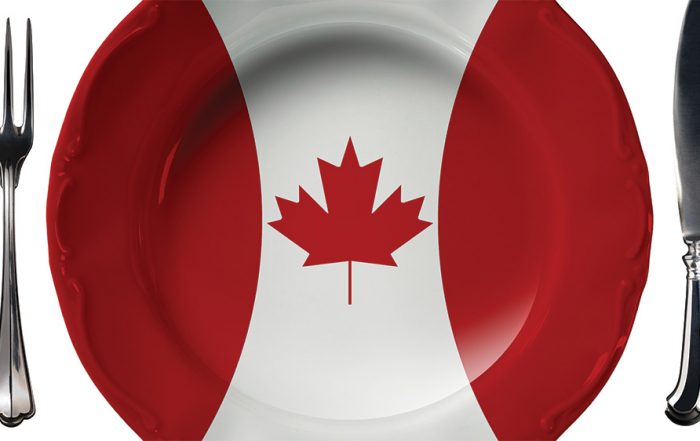
2016 Year in Review – Top 10 Food and Tobacco Product Issues in Canada
By Eileen McMahon, Teresa Reguly, Yolande Dufresne, and Manpreet Singh
The year 2016 brought a number of changes to food regulation in Canada that aligned with the federal government’s multi-year strategy to encourage Canadians to adopt healthier habits. With the support of Health Canada (the federal regulatory body overseeing the marketing and sale of food, drugs, and medical devices), legislation and regulations have been leveraged to raise consumer awareness of the nutritional value of food Canadians buy. As a result, a number of label changes have been mandated for the food industry, most taking effect over the coming years, including changes to the Nutrition Facts Table, the list of ingredients, and nutrition information on the front of food packages. These, and other important changes, are summarized below.
 1. Changes to Nutrition Facts
1. Changes to Nutrition Facts
In 2016, the federal government finalized changes to the Nutrition Facts Table (NFT) for food packaging, with the goal of assisting consumers in making more informed choices about the food they eat. The NFT amendments include changes to the regulation of serving sizes to better reflect the amount that Canadians typically eat and help consumers compare the nutritional content for similar foods packaged in different quantities. Other key changes to the NFT include a percent daily value (% DV) for sugars along with guidance (e.g.,“5% is a little, 15% is a lot”) footnoted below the table to help consumers understand how much sugar is in the food product.2 These changes are intended to display nutrient information in a manner reflective of Canadian diets. For example, nutrient information for potassium, a mineral under-consumed by most Canadians, will be added to the table, while information for vitamins A and C will be eliminated as these have been demonstrated to be abundant in most Canadian diets. For companies that do business on both sides of the Canada/US border, these NFT changes, which do not mirror current nutrition facts label requirements in the US, underline that we are unlikely to see a “North American” food label anytime soon.
2. Revised Format for List of Ingredients3
Labeling amendments finalized this year also extend to the list of ingredients found on prepackaged food products. Sugar-based ingredients, such as white and brown sugar, honey, molasses, and syrups (as well as less familiar sugars such as agave nectar and barley malt extract) will be grouped together as “sugars” and listed in decreasing order of their weight. This manner of labeling sugars is unique to Canadian food labels: the intent is to identify the source of sugars as well as better indicate how much sugar is in the food product relative to the other ingredients. Additionally, all food colors will be listed by their common name rather than by the generic term “color” and all words in the list will be in sentence case, with ingredients separated by bullets. The food industry has until 2021 to implement these changes and those to the NFT, noted in section 1 above.
3. Front-of-Package (FOP) Labeling Proposed4
Health Canada has also proposed a new approach for symbols on the front label of packages to indicate whether the food product is high or low in sugars, sodium, and saturated fats. How Health Canada will determine the thresholds used to classify the nutrients as “high” or “low” will be relevant to stakeholders. The proposal also extends to certain label claims and sweetener information. Health Canada’s rationale for FOP labeling is that giving consumers clear, visible and easy-to-understand information about sugars, sodium, and saturated fats better equips them to make healthy, informed choices. Consultations began in late 2016 with further consultations to follow in 2017. Implementation of FOP labeling is expected to align with updates to the ingredients list and NFT.
4. Canada’s Food Guide Under Revision5
This year, the government launched a process to modernize Canada’s Food Guide aimed at addressing the latest scientific evidence and better reflecting Canada’s changing demographics and lifestyles. Currently, the Food Guide is an all-in-one policy and education tool developed by Health Canada and used to communicate evidence-based dietary guidance and to promote good health. The Food Guide provides advice on the amounts and types of foods to eat, and the food and beverages to limit, such as those high in calories, fat, sugars, and sodium. It has been used to support individuals, set guidelines and policies in various settings such as schools and daycares, and develop nutrition education initiatives. However, a recent scientific review of the current Food Guide, last updated in 2007, found that although the principles underlying the dietary recommendations were sound, the Food Guide has limited practical value as it doesn’t distinguish between age groups, sex, or levels of physical activity.
Health Canada has indicated that the Food Guide will be revamped to strengthen healthy eating recommendations and address new scientific evidence relating to cardiovascular risk factors. The all-in-one approach will be abandoned in favor of a variety of guidance materials which will be easier to interpret and relevant to different Canadian audiences including First Nations, Inuit, and Métis. The revision process will engage various stakeholders through open consultations. New dietary guidance, updated healthy eating patterns, and supporting tools are expected to be released in late 2017.
5. Reducing Trans Fats by Banning Partially Hydrogenated Oils in Foods
Health Canada is proposing a ban on the use of partially hydrogenated oils in foods sold in Canada to decrease trans fats in the food supply to the lowest level possible. The ban on partially hydrogenated oils is intended to reduce the consumption of these ingredients by targeting food products such as margarines, commercially baked goods, and certain restaurant foods. Canadians and stakeholders were invited to comment on the proposal in late 2016. A 12-month implementation is proposed to allow the food industry to make any necessary changes and to deplete existing stock.
6. Marketing Food to Children to be Restricted6
The government announced that it will propose new restrictions on advertising products to children that are energy-dense and nutrient-poor, high in saturated fats, trans-fat acids, sugars, or sodium.
Health Canada is considering the age of children to whom the restrictions will apply, the scope of marketing covered by the restrictions (such as advertisements on television, radio, and Internet), and emerging forms of marketing like branding, product placement, sponsorship, and advergames. The food and beverages that will fall within the scope of the restrictions will also be considered.
The proposal is still in the early stages and no draft regulations have been published. The scope and criteria will be determined by Health Canada after consultation with relevant experts and stakeholders on the proposed approach before new restrictions are implemented.
7. Approval of the First Genetically Engineered Animal Food Source7
In 2016, Health Canada and the Canadian Food Inspection Agency completed scientific reviews of the AquAdvantage Salmon product, and approved its sale on the market as both a food product and a livestock feed. AquAdvantage Salmon is an Atlantic salmon that reaches market size more quickly than non-genetically engineered farm-raised Atlantic salmon due to the introduction of a growth hormone gene from the Chinook salmon. In order for a genetically engineered food to be sold in Canada, it must be approved for sale by Health Canada as a “novel food.”8 Similar to the U.S. process, for a novel food to be approved for sale in Canada, a manufacturer must provide data to the Federal regulator to establish that the food is safe for human consumption. Canada currently has voluntary standards9 for the advertising and labeling of GE foods, and some consumer groups argue that regulations mandating disclosure of GE products should be in place for transparency. GE products have the potential to provide lower-cost, nutritious food alternatives but public debate on how “good” GE products are for consumers and the environment is expected to continue for some time. Demands from constituent groups may place pressure on Health Canada to examine its policies, both on the time frame and the substantive requirements for novel food approvals and the advertising of products and ingredients that are produced by genetic engineering.
8. Regulations Still not Published for the Safe Food for Canadians Act
The wait continues for publication of the regulations under the Safe Food for Canadians Act10 (SFCA), which was passed in 2012. The SFCA is focused on interprovincial and international food commodities, and is directed at aligning Canada’s food safety system with those of Canada’s closest trading partners, including the United States. The SFCA consolidates into a single statute four pieces of existing Canadian legislation, namely the Fish Inspection Act, the Canada Agricultural Products Act, the Meat Inspection Act and the food provisions of the Consumer Packaging and Labeling Act, which were created at various times over the past decades. The SFCA also introduces increased enforcement and penalties, including fines of up to $5,000,000, for activities that put health and safety at risk. Before the SFCA comes into force, however, supporting regulations must be enacted. In June 2015, the Canadian Government published much-anticipated draft regulations. The preliminary draft included regulations related to the Canadian Food Inspection Agency’s (CFIA) tracing and recalling of food, certification of food commodities for export, and licensing and registration of imports of regulated food commodities to ensure a consistent approach for all food commodities. Food manufacturers, distributors, and retailers in Canada will want to continue to monitor the status of the regulations to keep themselves informed of the significant upcoming changes.
9. New Tobacco and Vaping Products Legislation11
Alongside the focus on healthy eating in 2016, Health Canada also directed its regulatory efforts on other products impacting lifestyle. The Government of Canada unveiled new proposed tobacco and vaping products legislation to regulate vaping products, implement plain package labelling requirements, and ban menthol in most tobacco products.
Under this modernized tobacco control agenda, vaping products would be regulated as a separate class of products. The proposed Tobacco and Vaping Products Act also contain provisions to allow adults to access vaping products as less harmful alternatives to tobacco use. As for tobacco packages, options such as standardized color, font and finish, and prohibitions on promotional information and brand elements, such as logos, are proposed by the bill. Prohibition of menthol, an additive used to improve the flavor of tobacco products, is also proposed. This means that nearly the entire tobacco market would be subject to a federal flavor ban. This concept builds on the prohibitions on the use of certain additives, including flavors, in all cigarettes to diminish their appeal to youth.12 The new changes are part of an ambitious effort by the Government of Canada to develop a Federal Tobacco Control Strategy. Consultations and forums on these proposed changes are expected to open in early 2017 to engage Canadian and other stakeholders.
10. Calorie Posting in Food Establishments13
Healthy eating initiatives also trickled down to the provincial level this year as Ontario’s Healthy Menu Choices Act, 201514 (HMCA) came into force on January 1, 2017. The HMCA requires large chain food service establishments, like fast food restaurants, to post calories on menus. The legislation applies to any food service establishment that prepares, sells, or serves meals or meal portions in a form that can be consumed immediately and that operates 20 or more establishments in Ontario under the same or substantially the same name, which means that only Ontario’s largest food service establishments will be required to comply. A variety of food establishments are captured under the HMCA including chain restaurants, fast-food outlets, grocery stores, and convenience stores. Establishments that meet the above criteria will be required to post the calorie content of: (i) each standardized portion of food or drink directly on the menu; (ii) any food item on display on an identifying tag or label; and (iii) any standardized combination of food or drink items directly on the menu. Failure to comply with Ontario’s forthcoming requirements could result in fines of up to $10,000 per day for corporations. It is yet to be seen whether other provinces in Canada will follow suit and enact similar legislation.
- http://news.gc.ca/web/article-en.do?crtr.sj1D=6&crtr.mnthndVl=12&mthd=advSrch&crtr.dpt1D=&nid=1169379&crtr.lc1D=&crtr.tp1D=&crtr.yrStrtVl=2016&crtr.kw=&crtr.dyStrtVl=1&crtr.aud1D=&crtr.mnthStrtVl=1&crtr.page=1&crtr.yrndVl=2016&crtr.dyndVl=31
- http://healthycanadians.gc.ca/healthy-canada-vision-canada-en-sante/healthy-eating-strategy-questions-answers-strategie-alimentation-saine-questions-reponses-eng.php?_ga=1.100511064.730549429.1482985132#q19
- http://news.gc.ca/web/article-en.do?crtr.sj1D=6&crtr.mnthndVl=12&mthd=advSrch&crtr.dpt1D=&nid=1169379&crtr.lc1D=&crtr.tp1D=&crtr.yrStrtVl=2016&crtr.kw=&crtr.dyStrtVl=1&crtr.aud1D=&crtr.mnthStrtVl=1&crtr.page=1&crtr.yrndVl=2016&crtr.dyndVl=31
- http://healthycanadians.gc.ca/health-system-systeme-sante/consultations/labels-nutrition-etiquetage/index-eng.php
- http://news.gc.ca/web/article-en.do?crtr.sj1D=6&crtr.mnthndVl=12&mthd=advSrch&crtr.dpt1D=&nid=1142009&crtr.lc1D=&crtr.tp1D=&crtr.yrStrtVl=2016&crtr.kw=&crtr.dyStrtVl=1&crtr.aud1D=&crtr.mnthStrtVl=1&crtr.page=18&crtr.yrndVl=2016&crtr.dyndVl=31; “Healthy Eating Strategy,” http://news.gc.ca/web/article-en.do?mthd=index&crtr.page=2&nid=1142029.
- http://healthycanadians.gc.ca/healthy-canada-vision-canada-en-sante/healthy-eating-strategy-questions-answers-strategie-alimentation-saine-questions-reponses-eng.php?_ga=1.100511064.730549429.1482985132#q10; http://news.gc.ca/web/article-en.do?mthd=index&crtr.page=2&nid=1142029.
- http://news.gc.ca/web/article-en.do?crtr.sj1D=6&crtr.mnthndVl=12&mthd=advSrch&crtr.dpt1D=6676&nid=1068309&crtr.lc1D=&crtr.tp1D=&crtr.yrStrtVl=2016&crtr.kw=Food&crtr.dyStrtVl=1&crtr.aud1D=&crtr.mnthStrtVl=1&crtr.page=3&crtr.yrndVl=2016&crtr.dyndVl=23.
- “Novel food” is a term defined by the Food and Drugs Regulations as a food derived from a plant, animal, or microorganism that has been genetically modified such that the plant, animal or microorganism exhibits characteristics or no longer exhibits characteristics that were previously observed, or has a characteristic that no longer falls within the anticipated range for that plant, animal, or microorganism.
- http://www.tpsgc-pwgsc.gc.ca/ongc-cgsb/programme-program/normes-standards/internet/032-0315/index-eng.html
- 1 SC 2012, c 24.
- http://news.gc.ca/web/article-en.do?crtr.sj1D=6&crtr.mnthndVl=12&mthd=advSrch&crtr.dpt1D=&nid=1158489&crtr.lc1D=&crtr.tp1D=&crtr.yrStrtVl=2016&crtr.kw=&crtr.dyStrtVl=1&crtr.aud1D=&crtr.mnthStrtVl=1&crtr.page=10&crtr.yrndVl=2016&crtr.dyndVl=31.
- http://news.gc.ca/web/article-en.do?nid=1147659&_ga=1.246975300.1907939418.1467916413
- https://news.ontario.ca/mohltc/en/2015/05/helping-ontarians-make-informed-nutritional-choices.html
- SO 2015, c 7, Sched. 1.
Update Magazine
January/February 2017







